Study on Shear Failure Process and Zonal Disintegration Mechanism of Roadway under High Ground Stress: A Numerical Simulation via a Strain-Softening Plastic Model and the Discrete Element Method
Abstract
:1. Introduction
2. Zonal Rupture Modeling of Roadway Perimeter Rock under High Stress
2.1. Base Range Modeling of Roadway Perimeter Rock Fragmentation Based on Discrete Element Approach
2.2. Perimeter Rock Damage Model of a Deep, High-Stress Soft Rock Tunnel Based on the Finite Difference Method
2.2.1. Modeling
2.2.2. Simulation Results
3. Analysis of Results
3.1. Zonal Rupture Pattern of the Roadway Enclosure
3.2. Mechanical Principle of Zonal Disintegration
3.3. Factors Influencing the Roadway Zonal Disintegration
3.3.1. Effect of the Surrounding Rock Strength
3.3.2. Effect of the Stress Environment
3.4. Effect of the Roadway Cross-Section
3.5. Compression Mechanisms of Anchor Rods
4. Discussion
- The results discussed in this paper are based on the simulation effect of numerical simulation software, so the conclusions may have idealized results. Including the homogenization and isotropy of the surrounding rock of the roadway, these are conditions that are difficult to exist in the real environment.
- The geological conditions of the mine are certain, and there is a risk of distortion by reducing a certain rock mechanical parameter one by one in the simulation test.
- In the process of excavation, the surrounding rock of the tunnel may be damaged, and this damage is usually shown on a three-dimensional scale, which is ignored in the two-dimensional direction of the simulation conducted in this paper.
5. Conclusions
- (1)
- Under high-stress conditions, the damage to a rectangular roadway started at its four corners. The fractured zones extended towards the deeper parts of surrounding rocks in a compression–shear conjugate fracture mode, forming a nearly rectangular fracture loop, whereas the four edges (the roof, the floor, and two sides) served as free surfaces. The rock masses within the fracture loop were extruded and loosened into the roadway, and the boundary stress of the fracture loop dropped, thereby forming a new free surface. Under high stress, the fractures developed toward the deep parts of the surrounding rocks in a compression–shear conjugate fracture mode along various sides of the fracture loop to form a new fracture loop. For a circular roadway, the loosening failure first appeared near the two shoulders and footings, accompanied by the formation of a nearly rectangular failure boundary. Next, zonal disintegration evolved and developed in the surrounding rocks. Thus, the rectangular and circular roadways showed similar development patterns of zonal disintegration.
- (2)
- Rock strength is a crucial factor in influencing zonal disintegration. Under fixed stress conditions, significantly fractured zones appeared only in shallow surrounding rocks and could not develop deep when rock strength was high. According to the Mohr–Coulomb model, the main factors controlling the development of zonal disintegration could be ranked in decreasing order as follows: cohesive force, internal friction angle, and tensile strength.
- (3)
- The stressed state is a key factor controlling the development of zonal disintegration. At low vertical and horizontal stresses, significantly fractured zones appeared only near the roadway perimeter surfaces. At high vertical stresses and low horizontal ones, zonal disintegration appeared on the roadway’s two sides. At high horizontal stresses and low vertical ones, zonal disintegration developed only in the roof and the floor. When both vertical and horizontal stresses increased, the extension range of the fractured zone grew steadily, while its structure became increasingly complex.
- (4)
- The fractured zones in the surrounding rocks formed under the compression–shear conjugate fracture mode originated from the roadway surface. Various layers of fracture loops were interconnected, forming a network, which was consistent with the elastoplastic slip line theory prediction.
- (5)
- In anchor-supported roadways undergoing zonal disintegration processes, the intact zone blocks slid relatively along the fracture surface during the process of loosening and deformation of the surrounding rock, making the anchor rods susceptible to tensile, shear, and bending actions.
Author Contributions
Funding
Institutional Review Board Statement
Informed Consent Statement
Data Availability Statement
Conflicts of Interest
References
- Qian, Q.H.; Li, S.C. A review of research on zonal disintegration phenomenon in deep rock mass engineering. Chin. J. Rock Mech. Eng. 2008, 27, 278–1284. [Google Scholar]
- Borisovets, V.A. Wave-type inhomogeneities in rocks near drilling-and-blasting zones. Min. Constr. 1972, 9, 7–11. (In Russian) [Google Scholar]
- Cloete, D.R.; Jager, A.J. The nature of the fracture zone in gold mines as revealed by diamond core drilling. S. Afr. Assoc. Mine Manag. 1974, 103. [Google Scholar]
- Adams, G.R.; Jager, A.J. Peteroscopic observations of rock fracturing ahead of slope face in deep-level goldmines. J. S. Afr. Inst. Min. Metall. 1980, 80, 204–209. [Google Scholar]
- Li, S.C.; Wang, H.P.; Qian, Q.H.; Li, S.C.; Fan, Q.Z.; Yuan, L.; Xue, J.H.; Zhang, Q.S. In-situ monitoring research on zonal disintegration of surrounding rock mass in deep mine roadways. Chin. J. Rock Mech. Eng. 2008, 27, 1545–1553. [Google Scholar]
- Li, S.C. Field Observation Analysis and Numerical Simulation. 21st Anthology of Academic Salon on New Ideas and Theories: Zonal Disintegration Effect of Surrounding Rock in Deep Rock Engineering; China Science and Technology Press: Beijing, China, 2008; pp. 82–88. [Google Scholar]
- Qi, C.Z.; Qian, Q.H.; Wang, M.Y.; Luo, J. Advance in investigation of zonal disintegration phenomenon. J. PLA Univ. Sci. Technol. Nat. Sci. Ed. 2011, 12, 472–479. [Google Scholar]
- He, Y.N.; Zhang, H.Q. Discussion on theory and practice of zonal disintegration in surrounding rocks of deep roadways. Chin. J. Rock Mech. Eng. 2008, 27, 2369–2375. [Google Scholar]
- Zhu, D.K.; Zuo, Y.J.; Chen, C.C. Analysis of deep surrounding rock supporting with zonal disintegration tendency. Nonferrous Met. (Min. Sect.) 2012, 64, 34–38. [Google Scholar]
- Pan, Y.S.; Li, Y.J.; Tang, X.; Zhang, Z.H. Study on zonal disintegration of rock. Chin. J. Rock Mech. Eng. 2007, 26 (Supp. 1), 3335–3341. [Google Scholar]
- Gu, J.C.; Gu, L.Y.; Chen, A.M.; Xu, J.; Chen, W. Model test study on mechanism of layered fracture within surrounding rock of tunnels in deep stratum. Chin. J. Rock Mech. Eng. 2008, 27, 433–438. [Google Scholar]
- He, Y.N.; Jiang, B.S.; Han, L.; Shao, P.; Zhang, H. Study on intermittent zonal fracturing of surrounding rock in deep roadways. J. China Univ. Min. Technol. 2008, 37, 300–304. [Google Scholar]
- Zhang, Z.H.; Wang, X.B.; Pan, Y.S.; Su, A.G. Experiment on layered observation of zonal disintegration of split similar material. J. Water Resour. Water Eng. 2010, 21, 1–5. [Google Scholar]
- Wang, X.B.; Bai, X.Y.; Ma, B.; Zhang, Z.H.; Lv, J.G. Effects of the heterogeneity of surrounding rock on the zonal rupture of roadway. J. China Univ. Min. Technol. 2019, 48, 78–86. [Google Scholar]
- Gao, F.Q.; Kang, H.P.; Lin, J. Numerical simulation of zonal disintegration of surrounding rock mass in deep mine roadways. J. China Coal Soc. 2010, 35, 21–25. [Google Scholar]
- Yang, P.; Zhang, S.; Wang, X. Numerical Study on the Characteristics and Control Method of Coal Leakage between Supports in Integrated Mining of Extremely Loose and Soft Coal Seams. Energies 2024, 17, 1013. [Google Scholar] [CrossRef]
- Li, L.H. Mechanism and Control of Lateral Strong Ore Pressure in Large and Thick Roof. Master’s Thesis, China University of Mining and Technology, Xuzhou, China, 2019. [Google Scholar]
- Zhang, S.K.; Lu, Q.K.; Zhang, X.D. A study on the stability of rectangular cross-section tunnel. J. Guangxi Univ. Nat. Sci. Ed. 2012, 37, 210–214. [Google Scholar]
- Zhu, Z.M.; Liu, K.; Kang, J.M.; Zhang, X.Y. Study of slowly unloading P-waves causing discrete fracture mechanism. Chin. J. Rock Mech. Eng. 2014, 33 (Suppl. S2), 3948–3955. [Google Scholar]
- Zhou, X.P.; Qian, Q.H. Zonal fracturing mechanism in deep tunnel. Chin. J. Rock Mech. Eng. 2007, 26, 877–885. [Google Scholar]
- Qi, C.Z.; Qian, Q.H.; Wang, M.Y.; Chen, J.J. Internal variable gradient plasticity model for zonal disintegration of surrounding rocks in deep tunnels. Chin. J. Rock Mech. Eng. 2012, 31 (Suppl. S1), 2722–2728. [Google Scholar]
- Wang, M.; Chen, H.; Li, J.; Li, X. Theoretical research on zonal disintegration of rock masses around deep tunnels and comparisons with in-situ observations. Chin. J. Rock Mech. Eng. 2018, 37, 2209–2218. [Google Scholar]
- Zhou, X.; Zhou, M.; Qian, Q. Influence of rock damage on zonal disintegration around deep circle tunnels. Chin. J. Solid Mech. 2012, 33, 242–250. [Google Scholar]
- Chanyshev, A.I. Plastic Deformation and Zonal Disintegration of Deep Surrounding Rock. 21st Anthology of Academic Salon on New Ideas and Theories: Zonal Disintegration Effect of Surrounding Rock in Deep Rock Engineering; China Science and Technology Press: Beijing, China, 2008; pp. 95–108. [Google Scholar]
- Shemyakin, E.I.; Fisenko, G.L.; Kurlenya, M.V.; Oparin, V.N.; Reva, V.N.; Glushikhin, F.P.; Rozenbaum, M.A.; Tropp, E.A.; Kuznetsov, Y.S. Zonal disintegration of rocks around underground workings. Part I: Data of in-situ observation. J. Min. Sci. 1986, 22, 157–168. [Google Scholar] [CrossRef]
- Su, Y.J. Study on Deformation Law and Control of High Stress Roadway in Lower Part of Multicoal Seam Mining in Close Distance in Jinhuagong Mine. Master’s Thesis, China University of Mining and Technology, Xuzhou, China, 2023. [Google Scholar]
- Wang, X.B.; Zhang, Z.H.; Pan, Y.S.; Zhang, C.Y. Numerical simulation of the influence of post-peak brittleness on the failure and energy liberation in the surrounding rock of a circular tunnel—Discussion on the difference between slip lines and zonal disintegration. J. Disaster Prev. Mitig. Eng. 2013, 33, 11–17. [Google Scholar]
- Li, S.P. Observation report of anchor test in roadways of Quantai coal mine and discussion on new viewpoint of anchor characteristics and parameter selection. J. China Inst. Min. Technol. 1979, 3, 19–57. [Google Scholar]
- Fang, Z.L. Maintenance Mechanism and Control Measures in Soft Roadways. Support Theory and Practice of Soft Mine Roadways in China; University of Mining and Technology Press: Beijing, China, 1996; pp. 64–69. [Google Scholar]
- Wang, M.Y.; Zhou, Z.P.; Qian, Q.H. Tectonic deformation and failure problems of deep rock mass. Chin. J. Rock Mech. Eng. 2006, 25, 448–455. [Google Scholar]
- Ma, N.N.; Li, J.; Zhao, Z.Q. Distribution of the deviatoric stress field and plastic zone in circular roadway surrounding rock. J. China Univ. Min. Technol. 2015, 44, 206–213. [Google Scholar]
- Wang, H.Y.; Zhang, Q.; Zhang, Y.; Jiang, K. Numerical simulation on disintegration of surrounding rock mass in deep mine roadways. J. China Coal Soc. 2010, 35, 535–540. [Google Scholar]
- Fang, Q.; Zhang, D.; Wong, L.N.Y.; Li, P.; Li, Q. Model test study of failure modes of surrounding rock for circular caverns. Chin. J. Rock Mech. Eng. 2011, 30, 564–571. [Google Scholar]
- Li, Y.; Zhou, Y.; Wu, S.; Wang, C.; Wang, Y. Deformation and failure of surrounding rock of circular tunnel using coupled continuous-discrete method. Chin. J. Rock Mech. Eng. 2015, 34, 1849–1858. [Google Scholar]


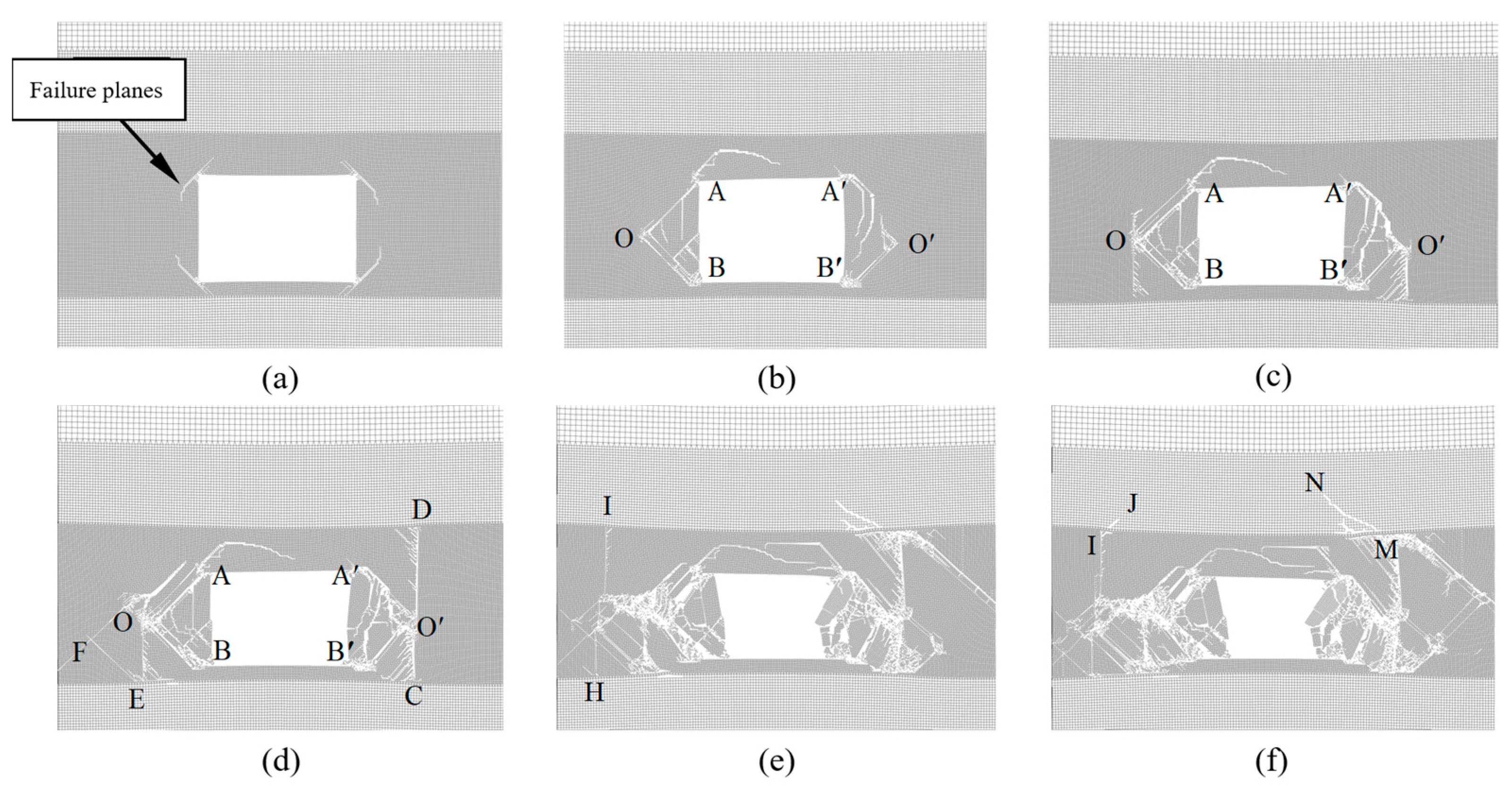
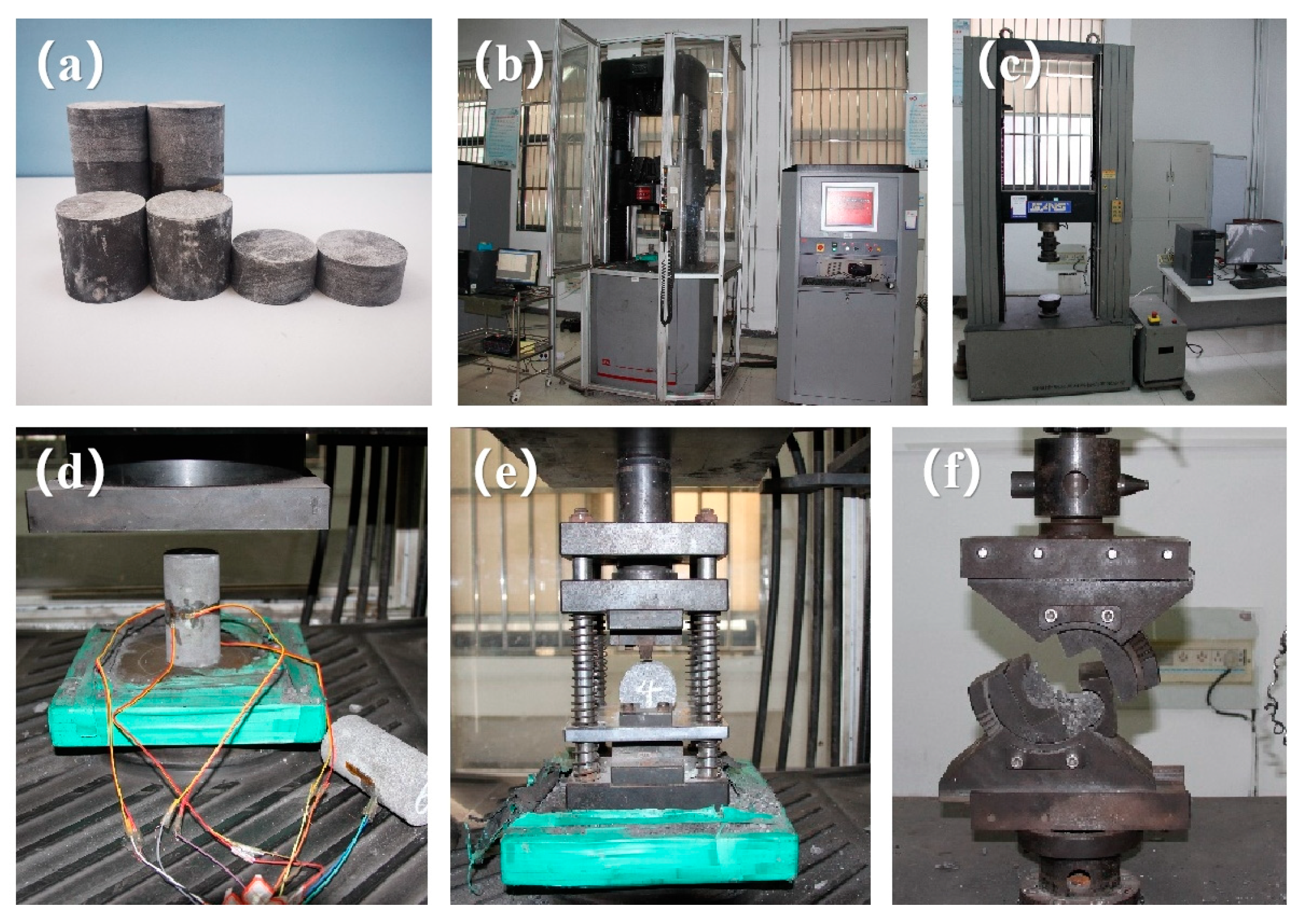

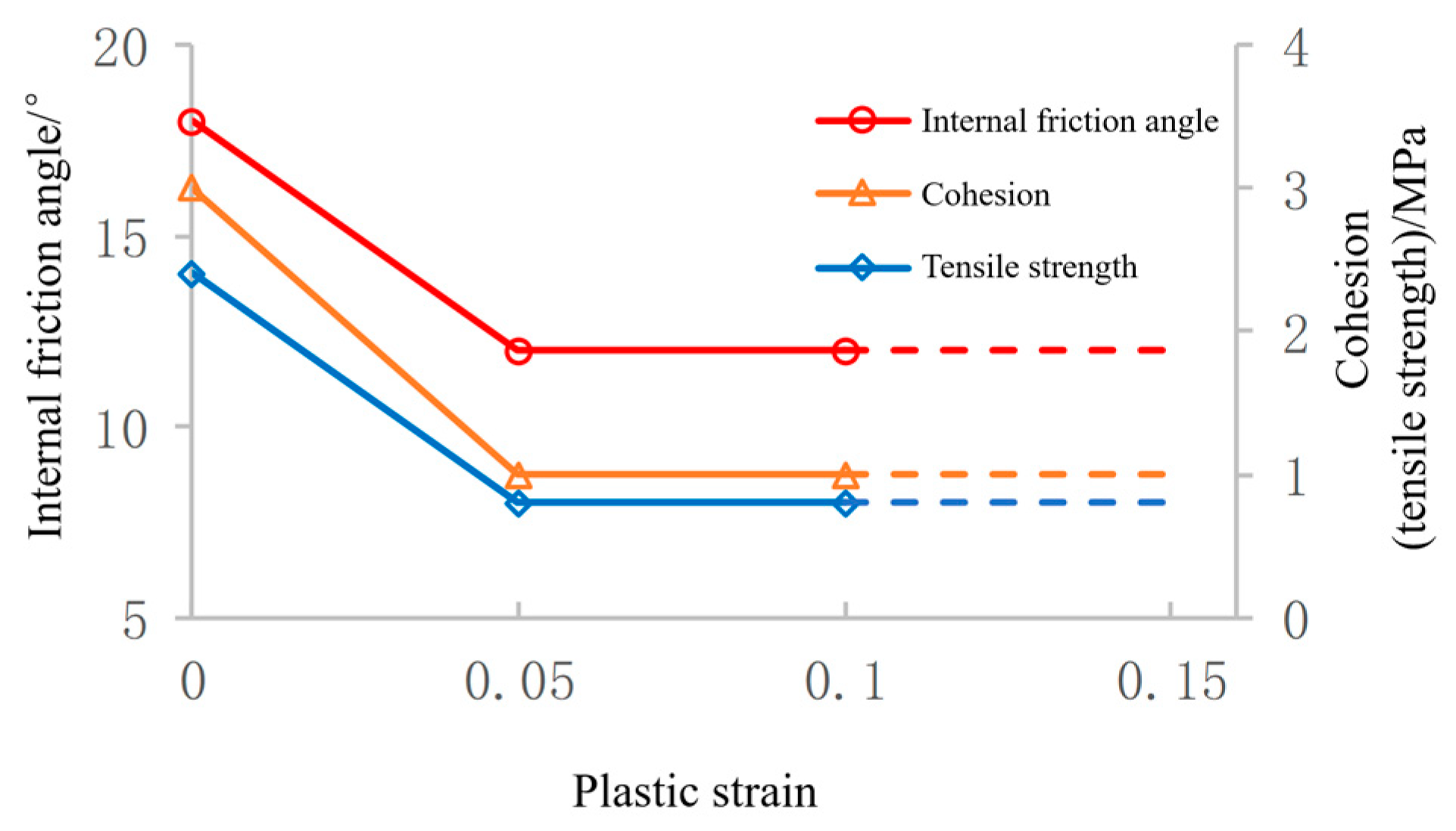

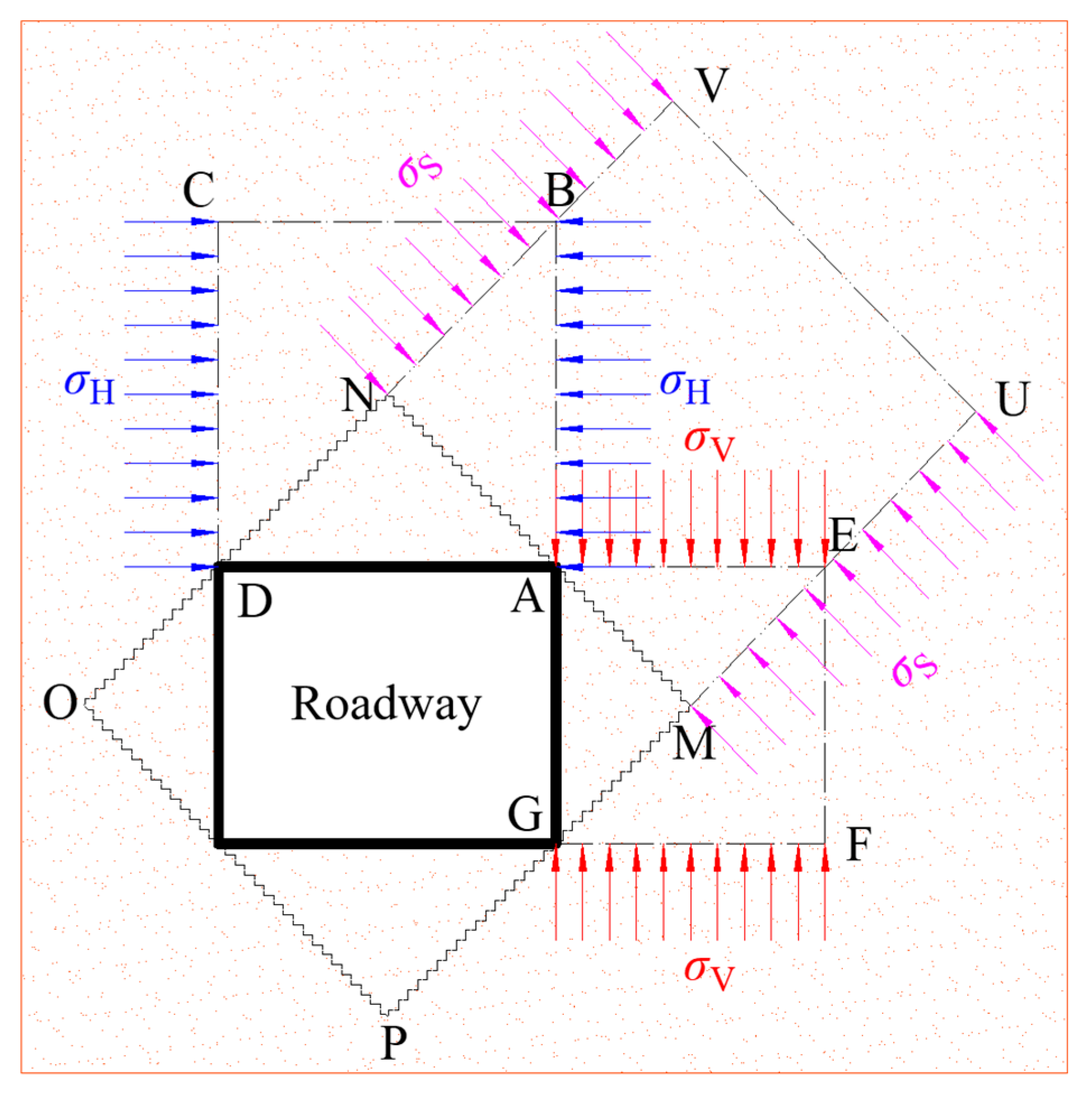
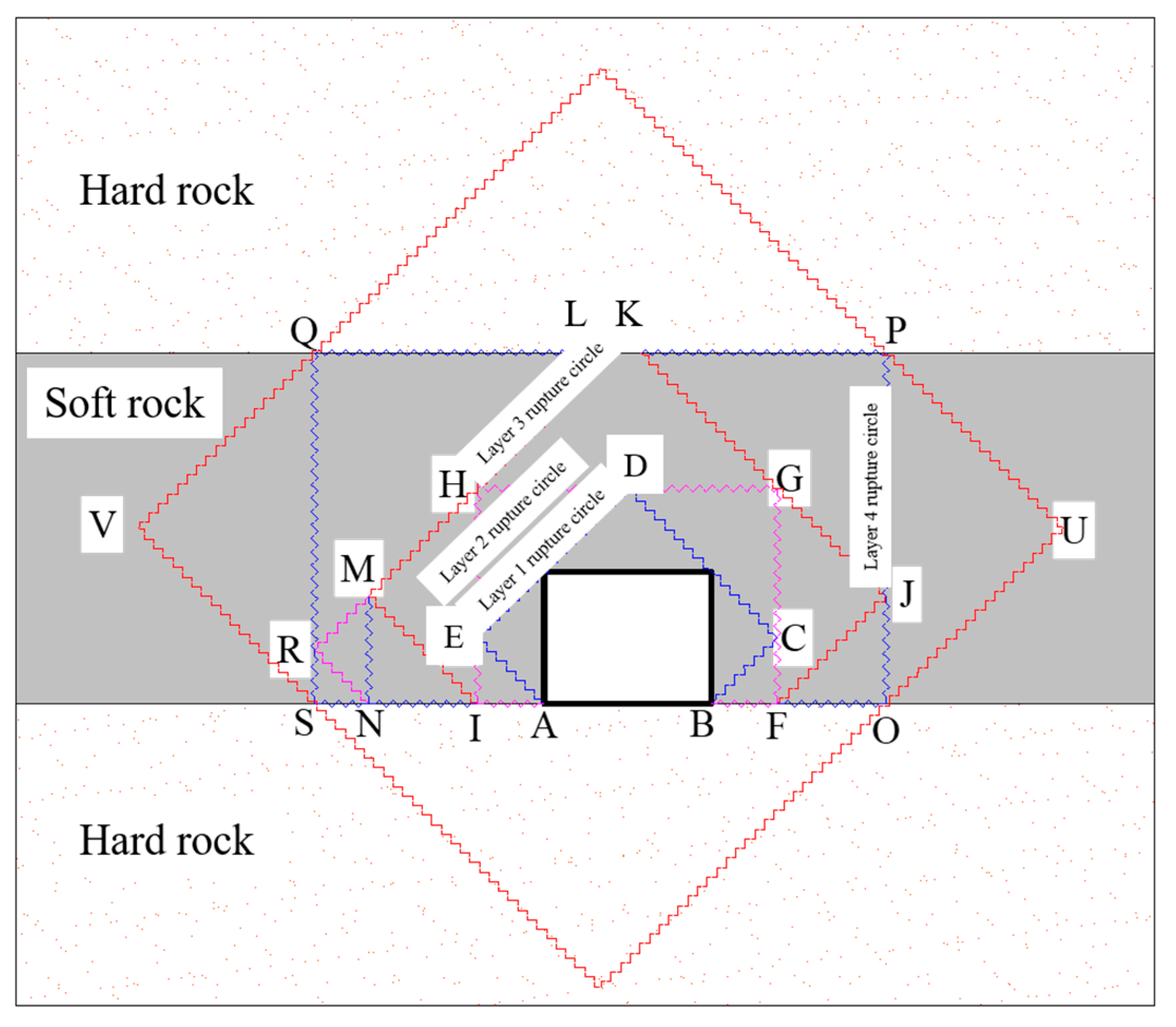


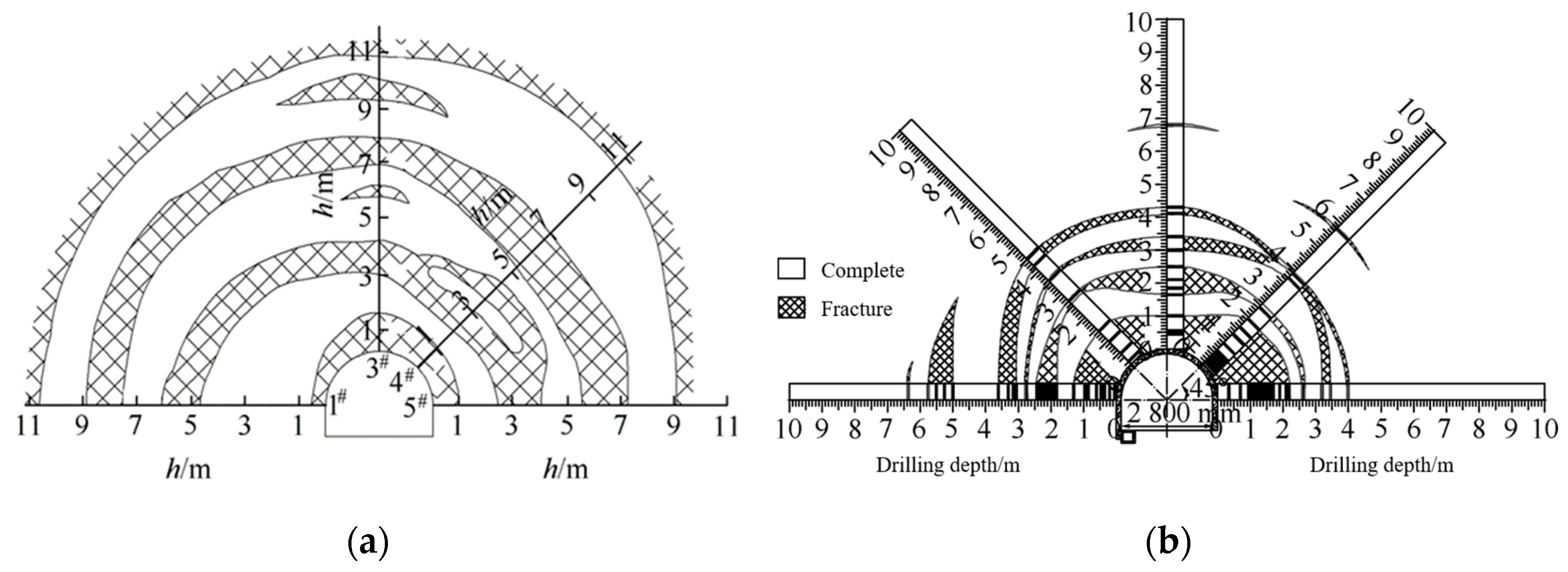
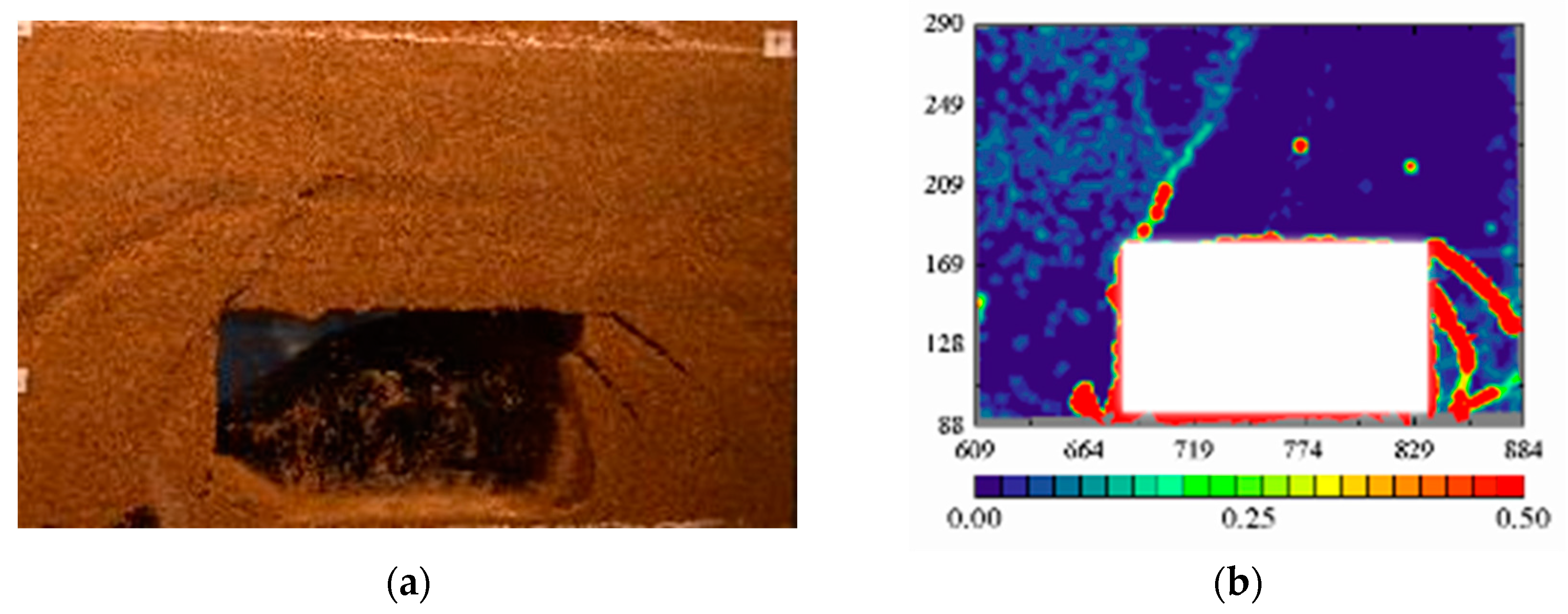

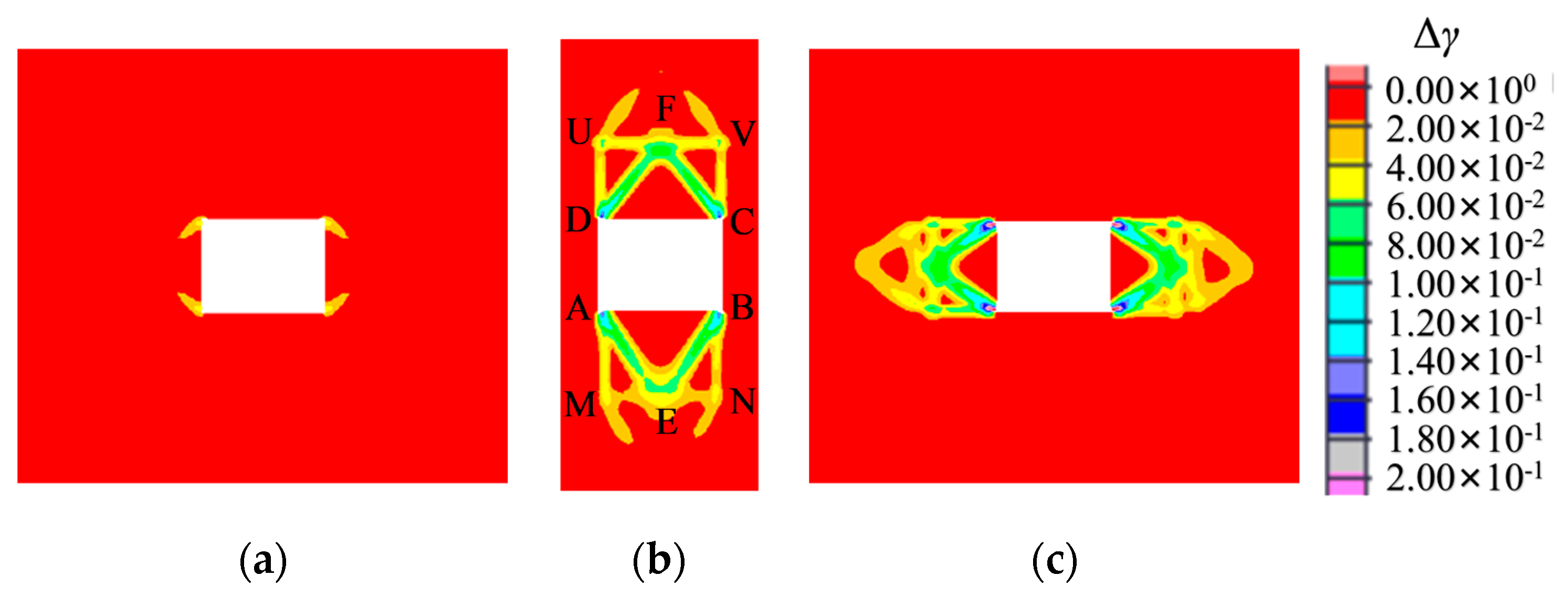

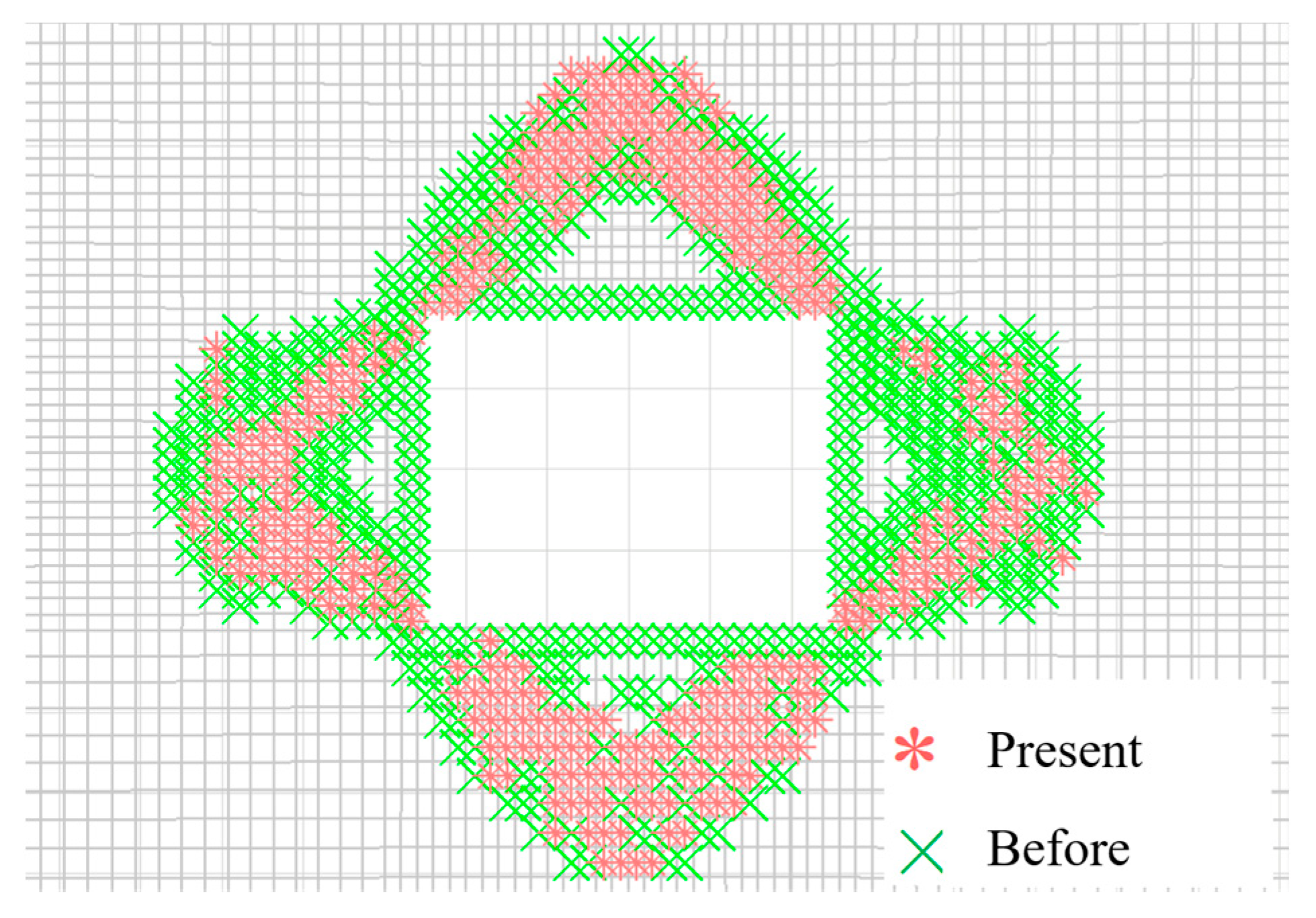


| Stratum | Normal Stiffness, GPa | Tensile Strength, MPa | Tangential Stiffness, GPa | Shear Strength, MPa | Frictional Coefficient |
|---|---|---|---|---|---|
| Upper roof/floor | 2.4 | 1.0 | 2.4 | 5.0 | 0.35 |
| Immediate roof/floor | 1.2 | 0.3 | 1.2 | 2.5 | 0.25 |
| Coal seam | 0.8 | 0.15 | 0.8 | 1.0 | 0.2 |
| Stratum | Densities, kg/m3 | Bulk Modulus, GPa | Shear Modulus, GPa | Cohesion, MPa | Internal Friction Angle, ° |
|---|---|---|---|---|---|
| Mudstone | 2300 | 1.2 | 0.3 | 1.0 | 16 |
| Scheme No. | Initial Strength | Residual Strength | ||||
|---|---|---|---|---|---|---|
| Internal Friction angle, ° | Cohesive Force, MPa | Tensile Strength, MPa | Internal Friction Angle, ° | Cohesive Force, MPa | Tensile Strength, MPa | |
| 1 | 36 | 3 | 2.4 | 24 | 1 | 0.8 |
| 2 | 18 | 6 | 2.4 | 12 | 2 | 0.8 |
| 3 | 18 | 3 | 4.8 | 12 | 1 | 1.6 |
| 4 | 18 | 2 | 2.4 | 12 | 0.8 | 0.8 |
| 5 | 12 | 3 | 2.4 | 9 | 1 | 0.8 |
| 6 | 18 | 3 | 1.6 | 12 | 1 | 0.5 |
| Design scheme | Scheme 7 | Scheme 8 | Scheme 9 | Scheme 10 |
| Vertical stress, MPa | 10.0 | 10.0 | 17.0 | 25.0 |
| Horizontal stress, MPa | 10 | 15.0 | 12.0 | 25.0 |
Disclaimer/Publisher’s Note: The statements, opinions and data contained in all publications are solely those of the individual author(s) and contributor(s) and not of MDPI and/or the editor(s). MDPI and/or the editor(s) disclaim responsibility for any injury to people or property resulting from any ideas, methods, instructions or products referred to in the content. |
© 2024 by the authors. Licensee MDPI, Basel, Switzerland. This article is an open access article distributed under the terms and conditions of the Creative Commons Attribution (CC BY) license (https://creativecommons.org/licenses/by/4.0/).
Share and Cite
Yang, P.; Zhang, S.; Liu, C. Study on Shear Failure Process and Zonal Disintegration Mechanism of Roadway under High Ground Stress: A Numerical Simulation via a Strain-Softening Plastic Model and the Discrete Element Method. Appl. Sci. 2024, 14, 4106. https://doi.org/10.3390/app14104106
Yang P, Zhang S, Liu C. Study on Shear Failure Process and Zonal Disintegration Mechanism of Roadway under High Ground Stress: A Numerical Simulation via a Strain-Softening Plastic Model and the Discrete Element Method. Applied Sciences. 2024; 14(10):4106. https://doi.org/10.3390/app14104106
Chicago/Turabian StyleYang, Peiju, Shurong Zhang, and Changyou Liu. 2024. "Study on Shear Failure Process and Zonal Disintegration Mechanism of Roadway under High Ground Stress: A Numerical Simulation via a Strain-Softening Plastic Model and the Discrete Element Method" Applied Sciences 14, no. 10: 4106. https://doi.org/10.3390/app14104106
APA StyleYang, P., Zhang, S., & Liu, C. (2024). Study on Shear Failure Process and Zonal Disintegration Mechanism of Roadway under High Ground Stress: A Numerical Simulation via a Strain-Softening Plastic Model and the Discrete Element Method. Applied Sciences, 14(10), 4106. https://doi.org/10.3390/app14104106






